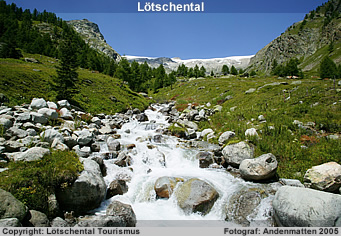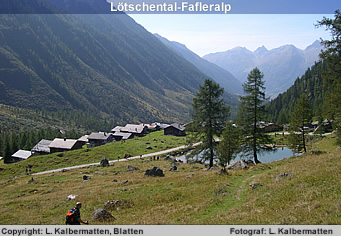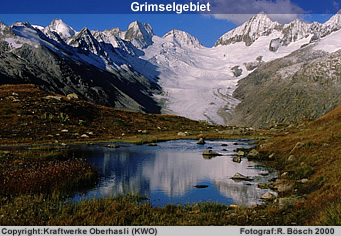| World Nature Heritage
in Switzerland |
 |
Schweiz - Switzerland |
|
|
|
 |
World
Heritage Jungfrau-Aletsch |
 |
 |
 |
|
View
from Tellital in direction Petersgrat |
 |
|
View
from Fafleralp with Lake Fafler and Faflerstafel |
|
| On
28 June 2007, at the annual meeting of the UNESCO World Heritage Committee
being held in Christchurch, New Zealand, the extension of the Jungfrau-Aletsch World Natural Heritage site was approved,
together with the management plan for this region.
Following
the positive decision adopted by the World Heritage Committee on 28 June
2007, the area of the first World Natural Heritage site in the Alps - the
Jungfrau-Aletsch region - is to be increased by 285 km2. This
represents an increase of more than 50 per cent over the current area of
539 km2. In the north-east, the extended site boundary now incorporates
almost the entire Aar Massif as far as the Grimsel.
The Schreckhorn, Lauteraarhorn,
Finsteraarhorn and Oberaarhorn peaks, including their glaciers, are to
be integrated into the World Heritage property. In the west, the extension
covers the areas around Gspaltenhorn, the Blüemlisalp group including
Petersgrat, Kanderfirn and the Doldenhorn group, and the slopes descending
to the Lötschen valley. |
|
As
a result of the site extension, the World Heritage area will also be considerably
increased in the existing boundary communes of Grindelwald and Lauterbrunnen
(Canton Bern) and the commune of Blatten (Canton Valais). Newly included
in the World Heritage property are parts of the Bernese communes of Guttannen,
Innertkirchen, Meiringen, Schattenhalb, Kanderste and Reichenbach, and
the Valaisian communes of Ferden, Hohtenn, Kippel, Steg and Wiler. Altogether,
26 communes have a share in the enlarged property.
The
extension of the existing World Heritage site rounds out the Jungfrau-Aletsch
region, which was originally inscribed in the UNESCO World Heritage list
in 2001 on the basis of its outstanding universal value. The existing site
is considerably enhanced by the increase in the total area (now 824 km2),
the substantially greater proportion of glaciated areas, and the integration
of new mountain landscapes. The property now encompasses the entire range
of the Bernese High Alps, falling away impressively to the north, on the
territory of Cantons Bern and Valais. The newly delineated site coincides
almost exactly with the two sites listed in the Federal Inventory of Landscapes
and Natural Monuments of National Importance (BLN) - the Bernese High Alps
and the Aletsch-Bietschhorn region. This significant UNESCO accolade places
an obligation on Switzerland to fulfil its responsibilities for the European
Alps and to ensure, through effective protection measures and sustainable
management, that this unique high Alpine region is preserved intact for
future generations.
The
decision of the UNESCO World Heritage Committee was in accordance with
the recommendations of the two IUCN (World Conservation Union) experts
who visited the nominated Jungfrau-Aletsch area last autumn
at the Committee's request.
With
its approval of the site extension, the UNESCO World Heritage Committee
also approved the management plan for the Jungfrau-Aletsch
World Heritage site. The clearly formulated management plan is commended
in a report prepared by the IUCN (World Conservation Union) experts who
visited the nominated region last autumn. Singled out for particular praise
was the fact that the plan was elaborated in consultation with the local
population in an exemplary participatory process.
The
UNESCO World Heritage Committee also recommended that Switzerland should
seek a new name for the enlarged site, and efforts in this direction are
already under way.
 |
 |
| View
from Grossen Scheidegg in in direction of Schwarzwaldalp with Engelhörnern
and Wellhorn. |
View
from Bäregg in direction Oberaar und Oberaarjoch. |
top
| Links |
 |
 |
 |
Externe Links |
| more information |
 |
|







